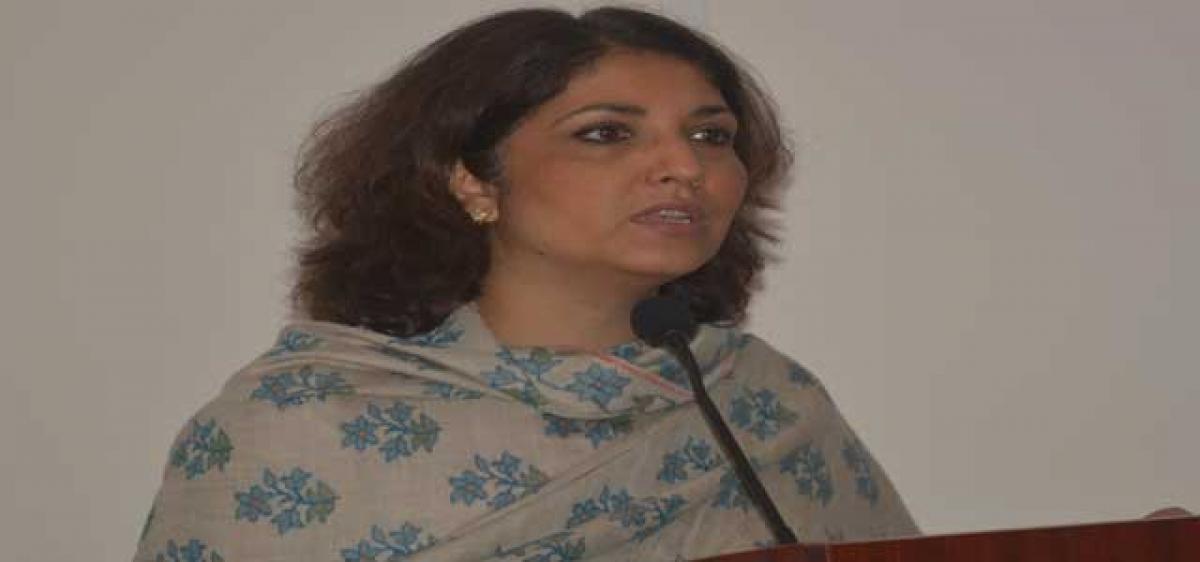Live
- Accused Sentenced to Life Imprisonment with Rigorous Punishment and Fined Rs. 25,000 for Murder
- ANR Centenary Celebrations Spread Across 31 Cities, Chiranjeevi to Receive ANR Award from Amitabh Bachchan
- Rahul Gandhi opposes quota abroad & violates Constitution: BJP MP
- Encounter breaks out in J&K’s Reasi
- RG Kar case: CBI custody of Sandip Ghosh, Abhijit Mondal extended till Sep 25
- J&K: Home Voting begins in all six Kathua Assembly segments
- Gurugram: Biker killed after being hit by SUV
- Bengal doctor’s body bars ex-member from all organisation activities over RG Kar case
- Centre and Seers serious over Tirumala Sacrilege
- LG ELECTRONICS ORGANIZES GRAND TECH SEMINAR IN HYDERABAD
Just In

The Deccan always evoked interest and curiosity among scholars and commoners. Although the Deccan has multifarious cultures it still remains an understudied region in South Asia. The themes of the seminar are Social Links, Cultural Networks Commercial Circulations, Political Negotiations and Economic Practices.
HK Sherwani Centre for Deccan Studies at the Maulana Azad National Urdu University (MANUU) is conducting a two-day international symposium titled ‘Networks in the Deccan’ on January 30 and 31
The Deccan always evoked interest and curiosity among scholars and commoners. Although the Deccan has multifarious cultures it still remains an understudied region in South Asia. The themes of the seminar are Social Links, Cultural Networks Commercial Circulations, Political Negotiations and Economic Practices.
Prof. Patrick Manning, Andrew W Mellon Professor of World History at the University of Pittsburgh, USA, delivered the first keynote address at the symposium. In the session ‘The Deccan in Global Context’ he briefly described how people from the world migrated to the Deccan.
“Human migration was both maritime and terrestrial from the start. People used to migrate from Africa to Asia and it was in both the directions. African people came to South Asia as slaves and freemen and they also came to the Deccan region. “As of 2015, the Deccan was one of the most populous regions in India,” he said.
The second keynote address was delivered by Dr Navina Haidar, Curator of Islamic Art, The Metropolitan Museum of Art, New York, USA. In her session, ‘Deccan’s Opulence’; she showcased the various arts of the region.
“The Deccan had five kingdoms, Ahmadnagar, Bidar, Bijapur, Golconda and Berar. Five various dynasties ruled here until it was conquered by the Mughals. There are many paintings and artefacts from the region. As an art historian, I can say that art is also a language.
Jagdish Mittal (historian and curator) has one of the good collections of Deccan art and that gave me the inspiration to pursue in this field. Deccani art had various influences from the regions like Europe, Turkey, etc.
We can also see that it had the influence of Deccan had connections with China. Many Chinese porcelain prints were used in the paintings and other art forms. Currently, I am doing a project on this,” she shared.
“We can see through the artworks of various artists that African nobility was a major part of the Deccan. Many paintings showcase their presence,” she added.
In the afternoon session, Dr Vasundhara Kavali-Filliozat, Professor (Retd.), Department of History, University in a plenary session delivered a talk on ‘Beginnings of Vijayanagara and its Legacy to South Indian Art and Architecture. Prof. Ishrat Alam, Professor, Department of History, Aligarh Muslim University talked about ‘The Dutch East India Company and Export of Iron and Steel from Deccan in the 17th Century’.
It was followed by ‘Exploring Commonalities in Art Forms of the Deccan: Shared Values in Poetry and Architecture’ by Sajjad Shahid, Co-Convener, INTACH; Secretary, Centre for Deccan Studies.
In the final session, Dr Klaus Rotzer, Archaeologist and Architectural Historian, Paris, talked about ‘Darshan Buildings at Bijapur during Adil Shahi Rule’. Independent Researcher and Collector from Bijapur, Ameen Hullur threw light on ‘The Defence System of Bijapur and its evolution from 1565 to 1686.
Dr Peyvand Firouzeh, Max-Planck Fellow at Kunsthistorisches Institute in Florence delivered a talk on ‘Connecting the Networks: Calligraphy, Piety, and Patronage’ in 15th Century Bidar. Dr Firouzeh is a Visiting Fellow at the HK Sherwani Centre for Deccan Studies.
Dr Shakeel Ahmad, Pro-Vice Chancellor, MANUU; Prof. Salma Ahmed, Director, HK Sherwani Centre for Deccan Studies; Prof. Rila Mukherjee, Department of History, University of Hyderabad; A Subhash, Assistant Professor, HK Sherwani Centre for Deccan Studies; Abdul Majid, Assistant Professor, HK Sherwani Centre for Deccan Studies, Prof. Kancha Ilaiah, Director, Al Beruni centre for the Study of Social Exclusion and Inclusive Policy, MANUU; Anuradha Reddy, Convener, INTACH were present among others during the symposium.

© 2024 Hyderabad Media House Limited/The Hans India. All rights reserved. Powered by hocalwire.com







